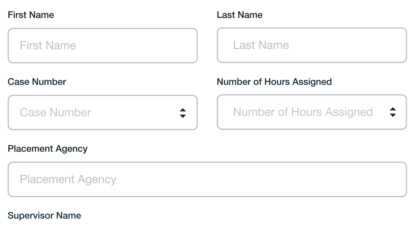The Importance of Website Forms
Enhancing User Engagement and Conversion Rates
Website forms are a fundamental element for businesses seeking to engage with their users effectively. Whether it’s collecting valuable user information, conducting surveys, or processing payments, forms are an essential component that can greatly benefit your business. In this article, we will delve into the significance of website forms and explain why they are indispensable for any website aiming to thrive in the digital landscape.
Why Website Forms are Crucial
Forms enable website owners the opportunity to easily collect valuable information from their users. This data allows businesses to customize their offerings according to the preferences and needs of their target audience. Additionally, forms can be utilized to conduct surveys, gathering feedback on customer satisfaction, product preferences, and overall user experience. Here are some key benefits of incorporating forms on your website:
Increased Conversion Rates
By making it effortless for users to provide their information, businesses can significantly enhance their conversion rates and generate more leads. Streamlining the process of capturing user data encourages higher participation and engagement.
Improved User Experience
Website forms contribute to an improved user experience by facilitating various actions. Users can effortlessly provide feedback, register for events, or make purchases through well-designed forms. By offering a seamless experience, you can foster a positive impression of your brand and encourage users to engage further with your website.
Streamlined Processes
Forms can help businesses streamline their operations by automating tasks. For instance, you can set up forms to send confirmation emails automatically or process payments without manual intervention. Such automation saves time and ensures a smoother user journey.
Enhanced Security
Implementing secure forms is vital for protecting user information and preventing fraudulent activities. By incorporating encryption and other security measures, you can instill trust in your users, assuring them that their data is safe.
Types of Forms You Can Implement
Depending on the unique requirements of your business, there are various types of forms you can implement on your website. Here are some common website forms:
Customer Facing Forms
Contact Forms
Allow users to reach out to you with inquiries or requests for more information.
Registration Forms
Enable users to sign up for memberships, events, or exclusive content.
Payment Forms
Facilitate online transactions and provide a secure platform for users to make payments.
Feedback Forms
Gather user opinions and suggestions to improve your products, services, or website experience.
Remember to choose the form types that align with your business objectives and user requirements.
Internal Operations Forms
Employee Application Forms
Employee application forms are used by businesses to collect employee information such as name, contact details, work history, and educational background. This form is essential for any business that wants to hire the right people to represent its brand.
Accident Report Forms
Working together with inspection forms are incident or accident report forms. These forms are used to report and record incidents, hazards, damages, and near misses after they happen and are then referred to later on to improve existing post-incident or accident processes.
Hazard Forms
Similar to incident, accident, and inspection forms, hazard forms aim to report distractions or threats. However, hazard forms specifically report threats to safety or operation procedures in the workplace.
Quality Control Forms
Quality control forms are used to monitor and assure a product’s, service’s, or process’ level of quality. These forms can be used during and after the production process to track quality and other instances of noncompliance along the way.
Best Practices for Creating Effective Forms
Creating effective forms is crucial to ensure accurate information and a seamless user experience. By following these best practices, you can optimize your forms for maximum efficiency:
Keep it Simple
Avoid overwhelming users with a lengthy or complicated form. Keep it concise and ask for only the necessary information. Simplifying the form will encourage completion and minimize user frustration.
Use Clear and Concise Labels
Provide clear and concise labels for each form field to guide users and eliminate confusion. Clearly indicate which fields are required and specify the type of information you’re seeking.
Provide Feedback
Acknowledge users’ actions by providing immediate feedback upon form submission. This could be in the form of a thank-you message or a confirmation email, assuring users that their form was successfully submitted.
Make it Mobile-Friendly
Ensure that your form is optimized for mobile devices. With the increasing number of users accessing websites via smartphones and tablets, it’s vital to provide a seamless mobile experience. Responsive design and intuitive user interfaces are crucial for mobile-friendly forms.
Common Mistakes to Avoid
While creating forms, it’s important to steer clear of common mistakes that can hinder user engagement. Here are some pitfalls to avoid:
Asking for Too Much Information
Requesting excessive or unnecessary information can overwhelm users and discourage them from completing the form. Only ask for essential details that directly relate to your business objectives.
Not Providing Clear Instructions
Ensure that you provide clear instructions on how to fill out the form. Users should understand each step and feel guided throughout the process.
Not Testing Your Form
Before deploying your form, thoroughly test it to ensure proper functionality. Test all the fields, buttons, and any additional features you’ve incorporated. This will help you identify and fix any issues or errors.
Not Optimizing Your Form for SEO
Optimizing your form for search engines can help increase its visibility. Incorporate relevant keywords in the form’s title, description, and fields. This will assist search engines in understanding the form’s purpose and relevance.
Website forms are invaluable for engaging users and gathering essential data. By implementing effective forms and avoiding common mistakes, you can ensure a smooth user experience, increase conversion rates, and optimize your website’s performance. Invest time and effort into creating user-friendly forms that align with your business goals, and you’ll reap the benefits of enhanced user engagement and improved customer satisfaction.
